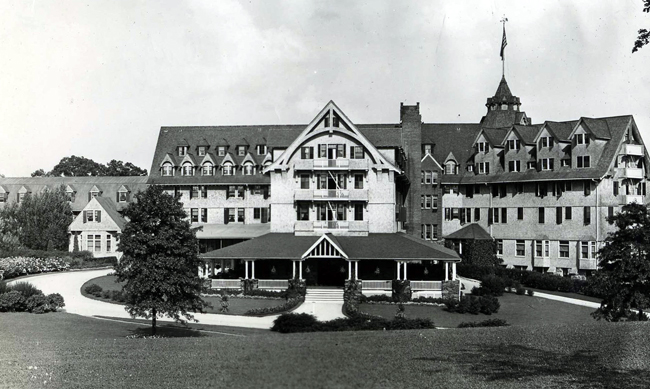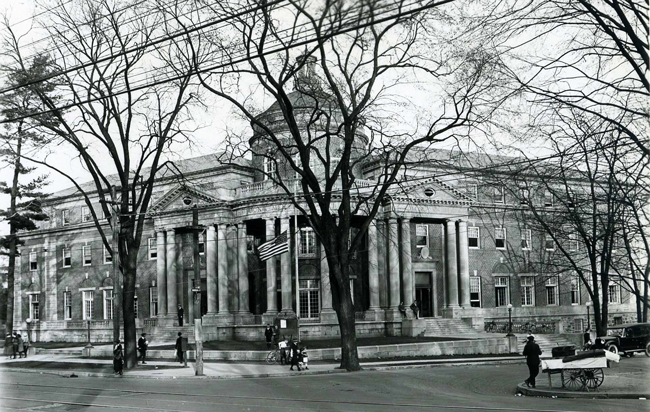 There is no doubt that Nathaniel Witherell left his mark on Greenwich. Evidence of his discerning eye and his knack for real estate development can still be seen today in some of the town’s most desired residential enclaves—Rock Ridge, Field Point Circle and Belle Haven.
There is no doubt that Nathaniel Witherell left his mark on Greenwich. Evidence of his discerning eye and his knack for real estate development can still be seen today in some of the town’s most desired residential enclaves—Rock Ridge, Field Point Circle and Belle Haven.
Nathaniel Witherell, a New York shipping magnate, bought the venerable Zaccheus Mead Farm in mid-country Greenwich in 1893 for about $15,000 and transformed its 162 fertile acres into Rock Ridge, a residential park. Roads were laid out, water pipes and sewer lines appeared, landscaping was begun, and each building lot, most of them three acres, was sold early on for $15,000.
The farm had been a Mead property since at least the mid-eighteenth century, and two Zaccheus Meads owned it, grandfather and grandson, shipping quantities of produce to New York City. Laura Mead, widow of Zaccheus Mead 2nd, retained a life estate in the property when it was sold to Witherell and continued to live in the old Colonial-style homestead until 1895.
Rosemary Cottage, built there for the Witherells, was a two and one-half-story home of fieldstone and frame in the Tudor style, with a steeply pitched roof and paired gables. The exterior of the basement and first levels is of fieldstone laid in random patterns, and above is half-timbering infilled with stucco. The roof with its notably flared eaves is sheathed in wood shingles, and each upper gable is topped with a turned finial, rising from a turned pendant.
 Where once stood a gothic-arched porte-cochere to protect visitors arriving in inclement weather is a fieldstone-walled terrace.
Where once stood a gothic-arched porte-cochere to protect visitors arriving in inclement weather is a fieldstone-walled terrace.
There were a number of outbuildings, typical of the era: a six-stall stable with carriage and harness rooms, hay loft and a man’s room above, a five-room cottage to house the coachman, a six-room gardener’s cottage, a greenhouse and an ice house.
The main entrance hall has a high, paneled wainscot of oak, and oak also covers the paneled doors, pilasters and ceiling beams. The south parlor, originally designated as the library, has bookcases with leaded-glass cabinets, wainscoting and overhead beams of cherry.
The dining room is trimmed in Flemish oak, the wainscoting is topped with a plate rack, and the massive fireplace mantel is accented by and egg-and-dart molding.
The second level has four bedrooms, three dressing rooms, three baths, three fireplaces and what was once a sewing room. One bedroom has a fireplace where both hearth and architrave are of glazed, creamy-colored bricks, with fluted Ionic columns surrounding the mantel and a frieze of garlands above. Hallways display elaborate moldings around the doors, windows and baseboards.
The attic, where once the in-house servants lived, has several oddly-shaped rooms and a single bath.
The original basement, as was not unusual at the turn of the 20th century, hosted the kitchen, along with pantries, laundry, a servants’ sitting room, a furnace room, cold storage and wood and coal bins.
Rosemary Cottage was designed by New York architect Henry C. Pelton, arguably best known for Riverside Church in Manhattan, inspired by a 13th century cathedral in Chartres, France. Pelton also designed the Cloisters, a branch of the Metropolitan Museum of Art in Fort Tryon Park in upper Manhattan devoted to medieval Europe. Closer to home, Pelton was the architect of the Indian Harbor Yacht Club and a number of private homes, including three on Dearfield Drive, including his own house at No. 51.
The Cottage was not the Witherell’s first home in Greenwich. Earlier, they summered in Belle Haven. Shifting styles, they had their first Belle Haven house rolled on logs to the corner of Otter Rock Drive and Walsh Lane and then built for themselves a new Tudor Revival on more than five waterview acres at 44 Mayo Avenue that they called “Fairholme.”
Together with Robert Bruce of Bruce Museum fame and Thomas Mayo, Witherell incorporated the Belle Haven Land Co. as a speculative capital venture in 1884 two years after the formation of the Belle Haven Casino Association, the forerunner of the Belle Haven Beach Club. Belle Haven would become the first planned residential park in Greenwich, then with beach, bath houses, lawn tennis and dock.
At the turn of the century, Witherell was also an officer of the Field Point Land Co., developer of Field Point Circle, adjacent to Belle Haven, but a separate entity.
Not content with the development of Belle Haven, Field Point Circle and Rock Ridge, he then turned his sights to the old Colonel Thomas A. Mead farm that ran between the Post Road and Rock Ridge. There he formed the Edgewood Park Land Co. in 1900 and financed the 150-room Edgewood Inn and Casino.

The Witherells were noted philanthropists. For six seasons, they invited 35 New York City working girls at a time for summer vacations at “Cherryvale House” in Rock Ridge. “The Fold,” their fresh-air home for city children, originally on Indian Field Road, was later moved to the Rock Ridge estate to assure an adequate water supply. As many as 200 children could be accommodated at any one time.
In 1901 they also donated five acres in Rock Ridge to Rosemary Hall to provide a new setting for the school, then housed in Wallingford. The school remained in Greenwich until 1970, acquiring an additional 13 acres by 1929, and then moved back to Wallingford in a joint venture with Choate.

—Written by Susan Nova, for the Greenwich Historical Society, March 12, 2012
The articles were featured in the greenwich.patch.com throughout 2012.

